
1.800.833.7958
► Español
► 中文
- PRODUCTS
- Water Sampling
- Groundwater Level & Flow
- Water Quality Equipment
- Water Sample Filtration
- Geophysical Measurements
- Handheld XRF Analyzers
- Unmanned Aircraft Systems
- Air Quality Instruments
- Soil Sampling Equipment
- Remediation Equipment
- Telemetry Solutions
- Industry Specific Equipment
- Field Equipment & Supplies
- Used Equipment Specials
- Product Specification Downloads
- RENTALS
- SALES & SERVICE
- CUSTOMER SUPPORT
- GEO NEWS
- ABOUT GEOTECH
Air Quality Instruments
Direct-reading air quality instruments or monitors provide information at the time of sampling, enabling rapid decision-making. These instruments provide the trained and experienced user the capability to determine if site personnel are exposed to airborne concentrations which exceed instantaneous exposure limits for specific hazardous air contaminants. Air quality monitors can be useful in identifying oxygen-deficient or oxygen-enriched atmospheres, immediately dangerous to life or health conditions, elevated levels of airborne contaminants, flammable atmospheres, and radioactive hazards. Direct reading instruments are particularly useful for identifying point source contamination or emissions such as gas leaks. Periodic monitoring of airborne levels with a real-time monitor is often critical, especially before and during work activities. Direct-reading instruments are useful for performing screening surveys to determine areas where additional evaluation is warranted.
| Photoionization Detectors (PIDs) |   |
PIDs use a fan or a pump to draw air into the instrument's detector. A high energy ultraviolet (UV) light source ionize the chemicals in the airstream. The charged molecules are collected on a charged surface, which generates a current that is directly proportional to the concentration of the chemical in the air being sampled. The ionization potential (IP) describes the amount of energy needed to induce ionization in a particular chemical.
PIDs are used for:
- Site characterization
- Exposure monitoring
- Soil and water sample screening
- Soil gas monitoring
| Single Gas Monitors and Tubes |
 |
Single or dual gas monitors are available from Geotech which can monitor carbon dioxide, carbon monoxide, hydrogen sulfide, and a variety of additional toxic gases. The sample concentration is displayed in ppm, percent oxygen or percent LEL (Lower Explosive Limit), as applicable.
| Multi-gas Hand-held Monitors |
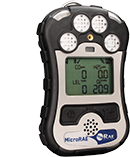 |
Multi-gas monitors incorporate separate sensors for oxygen, combustible atmosphere, and up to three toxic gases in the same handheld monitor.
These monitors may operate in passive (diffusive) mode, or in active mode, in which a pump module draws air across the sensors.
Many flammable gas sensors do not provide reliable readings in an oxygen deficient atmosphere. Therefore, oxygen content must always be determined before taking combustible gas readings. Flammable gases and vapors are tested second for fire or explosion risk. Monitoring for toxicity is conducted last. This monitoring process is greatly simplified by using a multi-gas monitor containing sensors for oxygen, LEL, and the relevant toxic gases.
| FID (Flame Ionization Detection) |
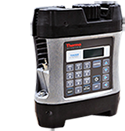 |
These units use a flame to ionize airborne contaminants. Once they are ionized, they can be detected and measured.
FIDs are the most sensitive for saturated hydrocarbons (alkanes), unsaturated hydrocarbons (alkenes and alkynes), and aromatic hydrocarbons.
| Particulate Monitors | 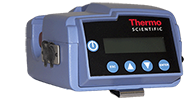 |
Aerosol photometers operate by detecting scattered light. The amount of light reaching the detector is proportional to the number of particles passing through the detection chamber. Also known as nephelometers, these instruments are used to monitor particulate matter such as dusts, smokes, mists, and fumes. They can be used for monitoring the respirable fraction of dust, and are small enough to use for personal exposure monitoring. Results are reported in μg/m3 or mg/m3.
| Air Velocity & Indoor Air Quality Meters |
 |
Velocity meters (hotwire anemometers) are handheld devices with an extendable wand probe used to measure air speed (velocity). They can be used to monitor the effectiveness of ventilation systems and local exhaust systems.
| Calibration Tools, Gases and Accessories |
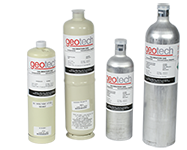 |
A complete line of gas meter accessories for your air quality instruments.
- RAE Calibration Stations
- Rechargeable and Replacement Batteries
- Automotive Adapter Cable
- Tedlar® and ALTEF Gas Sampling Bags
- Charcoal⁄Watertrap Filters
- Maintenance Kits
- Calibration Gases
- Gas Flow Controllers
- UV Discharge Lamps for Photoionization Detectors
- Replaceable Toxic Gas and Combustible Gas Sensors
- Hard-sided Waterproof Case
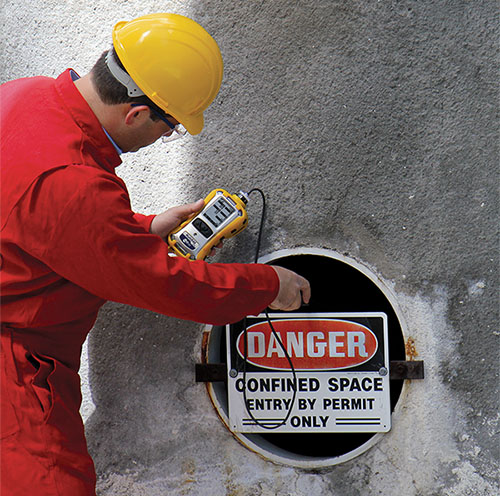
| Wireless Gas Detection |
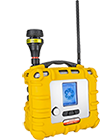 |
A range of environmental applications can benefit from wirelessly connected gas-detection systems. Today's industrial-grade wireless systems provide reliable safety monitoring that keeps workers and responders safe, and companies in compliance with government regulations.
Wirelessly enabled instruments, such as personal and hand-held monitors, also include an alarm notification system that sounds local alarms as soon as a threat is detected. Data from these monitors can also be wirelessly transmitted to a central location for data logging and analysis. This allows organizations to archive information for compliance review, mediation and remediation.
| Portable Gas Chromatographs (GC) |
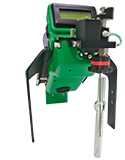 |
Defiant Technologies FROG-5000™ Portable GC
Portable Gas Chromatograph
The FROG-5000™ portable GC for environmental remediation, air quality testing, and many other applications brings the lab to the field by incorporating rugged durability with the fastest, most accurate, real-time monitoring available in a portable gas chromatograph system. Onsite analysis of volatile organic compounds (VOCs) in air, soil and water in ppm and sub ppm values is possible in less than 10 minutes for BTEX (benzene, toluene, ethylbenzene and xylene). Equipped with the same miniaturized components found in lab instruments for analytical chemistry, the FROG 5000™ portable GC provides unparalleled speed and accuracy never before seen in a field portable gas chromatograph.
- The lightest portable GC – weighs less than 5 lbs.
- Enhanced target analysis in less than 10 minutes
- Optimize real-time chromatogram view on PC
- Flexible operation in lab or field
- Intuitive operational design
- Screen, confirm, and qualify with Ellvin™ chromatography software
- Instrument innovation using Micro Electro-Mechanical Systems (MEMS)
- Detection of VOC analytes with ionization below 10.6eV
Call 1.800.833.7958
Defiant FROG-5000™ Portable GC Specifications
Defiant FROG-5000™ Portable GC User's Manual
Defiant FROG-5000™ Portable GC Quick Start Guide
| Multi-gas Monitors with PID |
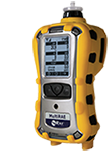 |
Multi-gas monitors incorporate separate sensors for oxygen, combustible atmosphere, and up to three toxic gases in the same handheld monitor. The sample concentration is displayed in ppm, percent oxygen or percent LEL (Lower Explosive Limit), as applicable.
Multi-gas monitors typically feature audible and/or visual alarms that warn of IDLH or time-weighted average toxic gas concentrations, low oxygen levels, LEL conditions, or malfunction. These monitors may operate in passive (diffusive) mode, or in active mode, in which a pump module draws air across the sensors.
| Landfill Gas Monitors | 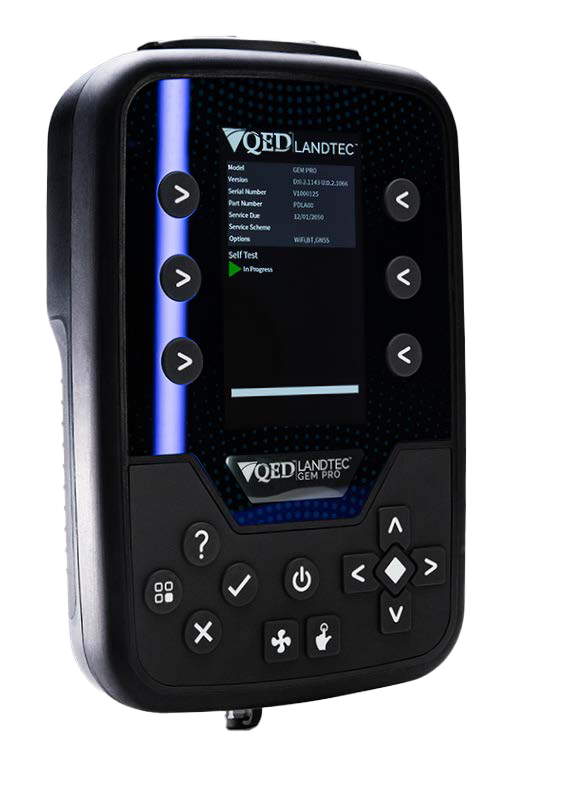 |
Specialized landfill gas (LFG) systems are used to extract, collect and control gas migration and surface emissions. LFG field monitoring is important for the safe and successful operation of LFG systems.
Geotech offers landfill gas monitors to sample down-well and surface gas emissions at landfills.
| Panther Gas Leak Detection |  |
Ion Science Panther
The Ion Science Panther is a versatile and dependable gas leak detection tool for professionals and was thoughtfully engineered to be an efficient device with quality features that make working with it simple. Its powerful micro thermal conductivity sensor provides precise and accurate measurements for a wide range of gases including helium, refrigerants, and hydrogen.
- Integrated torch for low lit areas
- Long rechargeable battery life
- Datalogging with Bluetooth connectivity
- Internal Gas Table
- IP44 ingress protection
Call 1.800.833.7958
Ion Science Panther Specifications
Ion Science Panther User Manual
| Mercury Vapor Analyzer |  |
Ion Science MVI (Mercury Vapor Indicator)
The world's ONLY mercury vapor surveyor, the popular hand-held Mercury Vapor Indicator is established as a firm favorite with a world-wide following.
You do not need to know where mercury is before measuring, the MVI finds the contamination and measures it quickly and accurately. The high performance pump lets you know immediately when tiny levels of mercury vapor are present.
- Large Digital Display
- Continuous Readings
- "One-Hand" Operation
- Audible Alarm Warns of High Mercury Level
- High Performance Pump – For fast indication and recovery
- PTFE Probe with Moisture Trap Filter
- Highly Accurate Measurement – Other monitors may only be accurate to plus or minus 20%!
- Very Fast – Almost instantaneous reaction to mercury, other monitors may require up to 1 minute to get a reading!
- Not Just a "Spot" Checker – MVI gives continuous readings
- No need to regenerate between readings
Call 1.800.833.7958
| High Vacuum Air Samplers |
 |
The easy to use, high vacuum samplers offer oil-less operation to ensure the discharge air remains free of contamination from lubricants. They produce minimal noise or vibrations, which makes them well suited for noise sensitive environments. In addition, these compact units offer high flow, pulse free air – making them ideal for applications requiring consistent air vacuum and flow. Environmental applications include:
- Air Sampling and Monitoring
- Sewage Aeration
- Soil and Groundwater Remediation
- Tank Aeration